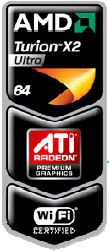AMD makes its notebook move; Puma goes live

AMD on Wednesday unveiled its notebook microprocessor platform, formerly known as Puma, and notched a small win over rival Intel. 
AMD's notebook platform (AMD Turion-X2 Ultra), which aims to integrate graphics capabilities with its processors, stays off Intel's ultra mobile PC turf, but has hit the market ahead of Intel's version, which was delayed late last month.
Scott Shutter, notebook division brand manager at AMD, said the chip maker's goal with its next generation notebook platform is to cover 80 percent of the market. That means AMD is ceding the high-speed niche of the notebook to Intel as well as the UMPC market. Shutter explained that the UMPC market just doesn't have the demand to warrant AMD's attention yet.
"Our roadmap has us going there (the UMPC market) in the future--the first half of 2010. We will have products that play into that space when we believe that growth warrants it," says Shutter.
Here's a look at AMD's target market:
After all, AMD needs to generate good profit margins by delivering multiple configurations to the largest chunk of the market. In one respect, AMD's notebook platform is designed to appeal to various customers ranging from gamers to consumers to small businesses. AMD's platform is designed to be a Swiss Army knife designed to fit multiple markets. AMD is pushing the graphic capabilities in its notebook chips as well as power savings. Both of these features are expected to appeal to commercial customers also as Vista is adopted.
The launch, the first one with ATI completely integrated, is an important milestone for AMD, which has been Intel's punching bag in recent years. Meanwhile, the two approaches between the chipmakers have been diverging. Intel talks about power, performance and energy savings. AMD talks platforms, plays down speed as the sole differentiator and talks about better graphics and virtualization capabilities. True to form, AMD didn't initially release speeds on its platform pending a press conference later today.
It's unclear how much the speed difference between Intel and AMD will matter in notebook chips. AMD's pitch was touting graphics performance. If it could beat Intel's speeds, it's safe to say we would have heard about it. The broader question is how much speed is valued in the overall microprocessor purchase.
A look at AMD's graphic performance claims:
"IT buyers look at laptops as commodities," says Shutter. "And our relationship is with the OEMs. As long as we have the feature set we'll see growth."
Here's a look at some of the slides in AMD's presentation:
AMD Turion's architecture:
AMD on the security features and pitching it to SMBs:
Multiple connectivity choices:
Graphics and battery life: